December 7- 13, 2014: Issue 192
Manly's Stone Kangaroo, Camera Obscura, First Maze and 'Chute' - Fun Days in Sea Hazes from 1857 On
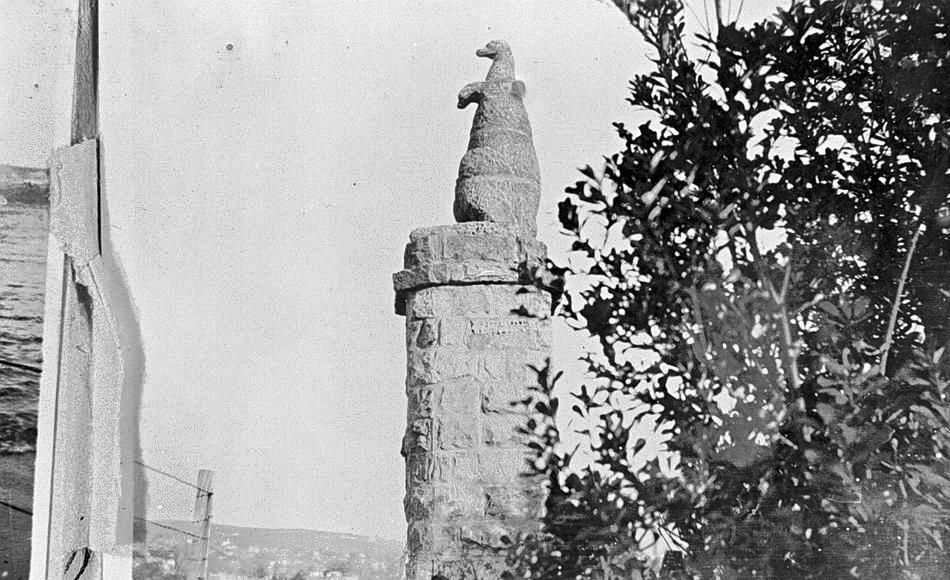
Statue of a Kangaroo, Carved by Convicts, Manly, New South Wales, (Photo; 1915 Mrs C Chisholm, 1915) courtesy - The Biggest Family Album of Australia, Museum Victoria, Image No.: MM 001014 - sources state was built/carved circa 1857.
Manly's 2014 Ocean Care Day is on today, Sunday 7th of December and many of you will be visiting our southern neighbour to get involved in or enjoy many of the events on.
There was a time when attracting people to Manly inspired constructing or placing some weird and not so weird edifices to attract people to what was then being promoted as a seaside resort. A rather badly made stone kangaroo, remarked upon by Charles DeBoos in his 1861 published My Holiday - states it must be a teapot,and where is the tea-room, he being in need of a cup after a half hour or so trudge from Manly Pier up to the aptly named Kangroo Hill.
Some sources state this little 'attraction' was made by convicts, although considering how many fine artists of every ilk served time here as convicts in early settlement days, the artisans who constructed this 'kangaroo' were not.
This was not all made to attract others to Manly at this early stage either - with lodging and dining places named after famous places or sea resorts in England, and even a proposition mooted at one stage to rename the place 'Brighton' - emulating what worked elsewhere also seemed to be the recipe for success here.
People poured into Manly as soon as access via steamers made this affordable and went 'sea-bathing' before, during and after a ban on such public displays of knees and ankles. Thousand of people during the 1860's had become one million for the Summer of 1898.
It is the entertainment 'attractions' we'd like to share a few insights on though and if feeling adventurous this Summer, some details on how you might make your own Camera Obscura.
Mary Salmon, whose article appears below, wrote a number of historical articles for Sydney publications
BEAUTIFUL MANLY.
(WRITTEN FOR THE "EVENING NEWS" BY MARY SALMON.)
AS a watering place, convenient to the city, yet complete in itself, Manly has no compeer in Australasia; nor, indeed, could any seaside suburban village be more delightfully situated. If we except the rather dreary-looking Quarantine Station on the North Head, which, to some slight degree affects the picturesquesness of the water approach, there is nothing that is not beautiful in Manly and its environments. The double advantage of a fine harbour beach, as well as the long stretch of level sand on which the ocean breakers roll, give it a distinction that does not belong to any other suburb. Then the level valley plain on which the township stands, with the surrounding hills and undulating country, stretching to Curl Curl Lagoon, with the bold headlands on two sides and the ocean on the other, gives one, standing on the Tower or Kangaroo Hill, a panoramic view that is truly impressive. The soft grayish green foliage covering the hills, the turquoise tint of the sea, and the deep mystic green of the Curl Curl lakes, with the glistening lines of the sea beaches, make up a scene of beauty that has appealed to many thousand visitors. Summer and winter alike Manly is pleasant to live in, for, like most waterside places, it is cooler in the summer and lacks the rigid severity of in-land places in the cold season.
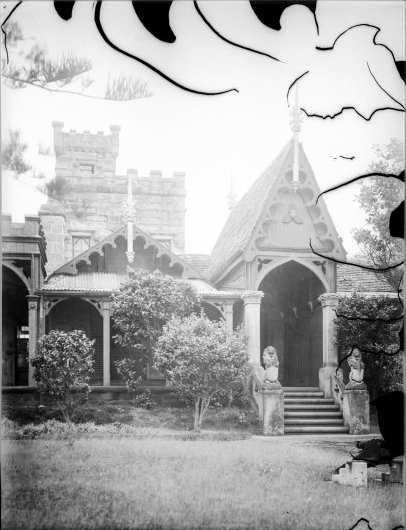 Though the resident population is only about 5000, the interest in the district extends over many times that number, since everyone who visits Sydney makes at least one trip to see the beauties of Manly Cove. There are only about 1073 residences, but many of these are mansions, there being absolutely no hovels, nor any sign of extreme poverty in one of the eighteen miles of streets within the municipality. That magnificent structure overlooking Shell Bay and Fairy Bower, the Cardinal's Palace, and the Catholic College, may be seen for many miles in any direction; whilst on the Fairlight end, on Tower Hill, stands the historic Dalley Castle, monumental of the statesman towards whom every Australian heart feels warm. The fine spire and chastely severe architecture of the Presbyterian Church, though needing the mellowing influences of age, also aids in making Manly attractive. But the chief object of which the suburb may well be proud are her reserves, the cricket ground and neighbouring park more particularly being beautifully situated, well kept, and nicely seated. The sea walls, both on the ocean and inland beaches, are valuable acquisitions, as also are the boulevarded streets and esplanades.
Though the resident population is only about 5000, the interest in the district extends over many times that number, since everyone who visits Sydney makes at least one trip to see the beauties of Manly Cove. There are only about 1073 residences, but many of these are mansions, there being absolutely no hovels, nor any sign of extreme poverty in one of the eighteen miles of streets within the municipality. That magnificent structure overlooking Shell Bay and Fairy Bower, the Cardinal's Palace, and the Catholic College, may be seen for many miles in any direction; whilst on the Fairlight end, on Tower Hill, stands the historic Dalley Castle, monumental of the statesman towards whom every Australian heart feels warm. The fine spire and chastely severe architecture of the Presbyterian Church, though needing the mellowing influences of age, also aids in making Manly attractive. But the chief object of which the suburb may well be proud are her reserves, the cricket ground and neighbouring park more particularly being beautifully situated, well kept, and nicely seated. The sea walls, both on the ocean and inland beaches, are valuable acquisitions, as also are the boulevarded streets and esplanades.
Right:: Dalley's Castle, Manly, New South Wales, ca. 1939 by Edward William Searle, nla.pic-vn4654639,courtesy NationalLibrary of Australia.
Whilst Manly has grown within the last fifty years into supremacy as a watering place, it was as far back as 1789 that the white man first visited the cove, when its christening ceremony took place. This maybe called an untoward accident, since the victim himself, Governor Phillip, only looked upon the incident as such. He, with Captains Johnson and Collins, Surgeon White, Mr. Waterhouse, and Dr. Balmain, landed from the boats of the Sirius, in search of a high point to erect a column or land mark for vessels. Benelong and Cobby were there with the wild blacks, feasting on a dead whale. As Governor Phillip advanced with outstretched hands to greet them, one of the natives, Willie-ma-ring, not understanding the mark of friendship, threw a spear from his womera which entered the Governor's right shoulder above the collar-bone, coming out three inches lower, at the back. Such was Governor Phillip’s humanity that he refused to let vengeance be taken, recognising that it was only a mistake, and not savagery, and he called the place "Manly Cove," "For," he said, "they are fine, manly fellows."
The same party on another occasion walked from the Cove to Pittwater, which they named after the great statesman. It has been asserted, and the Hon. George Thornton believed it, that the creek, of which traces yet remain at Ashburner-street, was at one time, so extensive that captains have brought their vessels through for a short cut from the Coal River (Newcastle), the statement of a Captain Minall supporting this theory; but there is certain proof that it has been many hundreds of years since the North Head was an island, perhaps even thousands of years may have passed since this was the case.
Some twenty years ago some alarmists (when the tidal waves had flooded Manly) prophesied the destruction of the township in this way, a consequence being that property for a very short time depreciated, but it was discovered that in every part of the low levels skeletons of natives were dug up in a fair state of preservation, proving that the submersion theory of the flat was untenable. Mr. Adam Russell, who planted Manly with trees, says, "I never dug a hole without coming upon some portion of a skeleton, particularly in the low levels."
Many years passed before any person of importance took up acres or made a home there; only a few fishermen and a wood-cutter or two living in humpys round the shore. When the blacks saw vessels in the distance passing from Coal River they carved on the rocks "white fellows' canoes" mingled with their own grotesque figures of men, birds, and animals. These were to be seen until recent years on the rocks of unfrequented spots.
But it is Mr. Henry Gilbert Smith who may be called the "father of Manly," since he bought 100 acres on the flat at a nominal rate, and set to work to build. The Government had previously surveyed a township — Balgowlah — on the Sydney road, and streets had been pegged out, but the land lying in the valley was more come-at-able from Sydney, and the nucleus of a village sprang up. The Steyne, Pier, and Clarendon hotels were built by this gentleman, whose imported iron house, where he lived, stood on the beach close to what is now the Pier Hotel. He fixed the hundred feet from high water mark on both beaches, with an idea of a main central avenue. But there was no communication with Sydney except by private boats, Mr. Skinner, the father of the present manager of the municipal baths, being the boatman who took Mr. Smith to town and back in his dingey. Thirty acres were added to Mr. Smith's estate from the Barker grant and a grant to Thompson to 1842, and the Skally and Andrews estates made up the Fairlight property, now so beautified and improved.
The Basset-Darley property was so called from land owned by Miss Wentworth, daughter of W. C. Wentworth, who married first a Mr. Basset and then Captain Darley. Previously to this entrance of civilisation, in 1836, in Governor Bourke's time, the parish of Manly was computed to contain 43 souls, including 14 Government men clearing the quarantine ground.
"In 1850,"says a writer, "the district was nearly as wild as when Captain Phillip first found it."
Charles De Boos says, "the beginnings were all in tyranny, blood, and crime;" but these things have all passed away with happier and more settled conditions. A sort of "cattle duffing," amounting to bushranging, prevailed, some murders being committed, which even living residents remember, and much "dark work" going on in those wild and lawless days, it being too far away and ungetatable for Sydney to exercise much control. The names of some of the early settlers were the Whalans, Collins, Parker, Mildwater, Miles, Wilson, Fell, Smith, and Symons, many of whose relations are still an the district, though none of the originals remain to tell of Manly prior to the settlement by Mr. Henry Gilbert Smith, about 1852. The Skinners, Mr. Adam Russell (for 21 years overseer of works), Mr. Bagnall (an early builder for Messrs. Elphinston), and Mr. Badmington, senior (also a builder) are among the oldest living residents.
The Ivanhoe Park was laid out under Mr. Smith's direction; also the planting of Port Jackson fig trees and Norfolk Island pines in the esplanades and the Corso. "The Brothers" was a little boat that, in '54, was owned by Mr. George Hall, and came irregularly to Manly, succeeded by the Phantom, brought from Melbourne, in 1858. For many years there were only three trips a day, the return fare being 2s 6d. When Manly was boomed into a fashionable seaside resort, the big ocean steamers to Newcastle brought excursionists down in the mornings on holidays, but at night only the usual small boats would come over to return the picnickers to their homes, the consequence being that many an all-night's outing was included in the picnic. Parties of forlorn pleasure-seekers might be seen sitting in the ti-tree scrub that at the time bordered the beaches.
Old residents tell of the "hot potato club," when the Phantom made a late trip from town during election or other exciting evenings in the city. The early arrivals at the Sydney Wharf, where (should the night be stormy) was provided no shelter, went at once on board, and did the potato roasting in the engine fires, having hot coffee and bread and butter ready for supper during the trip. Songs and speeches made the journey pass quickly. Mr. Robert Grant is the best-remembered among the club presidents. When the Breadalbane was put on the engine was forbidden for cookery purposes, and the club ceased to be.
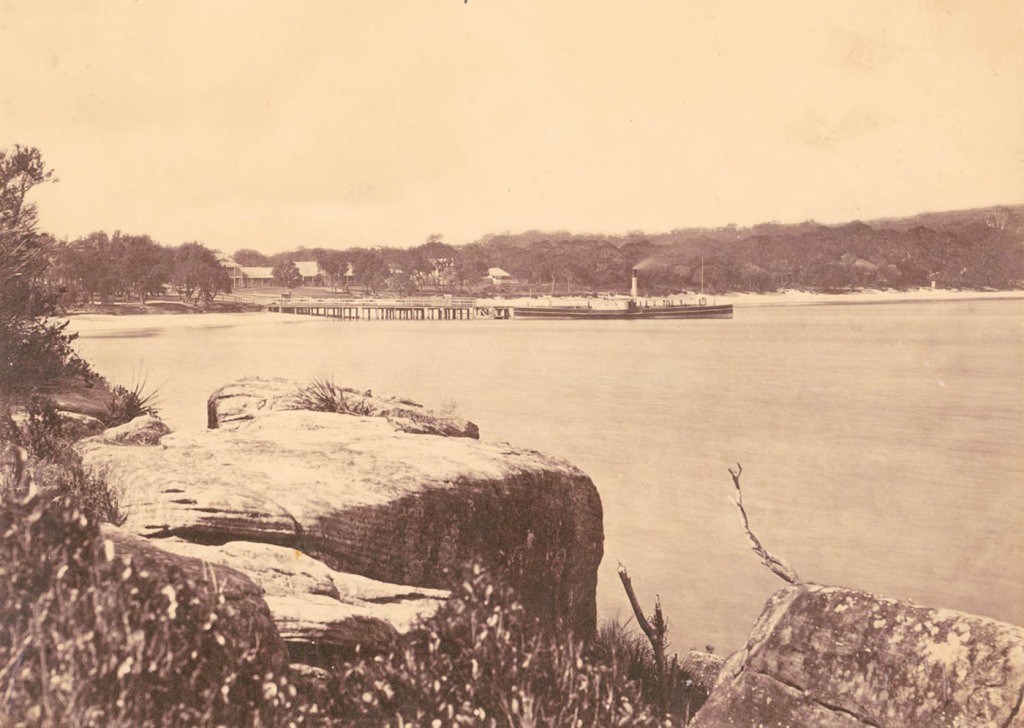
'Phantom' paddle-steamer at Manly Wharf, circa 1870, The `Phantom' (built in 1858) started on the Manly route in 1859. Picture No.: a089691, courtesy State Library of NSW.
The kangaroo, on the hillock of that name, now a reserve, was designed by Mr. H. G. Smith as a memento of the great wallaby chases that were a feature of Manly in days gone by. The intention of the carver was good, though the libel on our national animal is almost unforgivable. The camera obscura, also standing, was another effort of the same gentleman to boom Manly, as also was the maze, erected on what is now part of Ivanhoe Park, behind the Pier Hotel.
Tradition says that it was at a wallaby hunt that the idea of the incorporation started. At all events, the borough was proclaimed in 1877, Mr. Thomas Rowe being first Mayor, in 1877 and 1878; Mr. G. W. Barker followed; then Mr. J. J. Lough, Mr. C.H. Hayes in 1883 (three times elected), the present Mayor being Alderman E. W. Quirk, M.L.A., J.P. The present aldermen are Messrs. F. C. Passau, J.P., O. Carroll, J.P., J. F. Walker, Adam Russell, D. S. Ogilvy, J. B. Meyer, J. J. Dargan, and A. Ogilvy. Mr. Alex. Dean and Mr. John Woods have also worked well for the district.
Second to the name of Mr. H. G. Smith stands that of the Hon. William Bede Dalley, M.L.C., in local importance, though to the world at large Mr. Dalley figures in far more consequence. A hobby of this brilliant and magnetically interesting man was the building of fine houses, as places to which he could retreat amid surroundings that appealed to him, to pen his literary sketches, notably the "Political Biographies," which he contributed to "Sydney Punch," in her palmist days; for it was as a writer, as well as a successful and powerful criminal pleader, as a politician, and as an art connoisseur, that this gifted man was distinguished. A collaborateur in early life with the late Daniel Henry Deniehy, whom he truly called "incomparably the most gifted Irish-Australian of our history," Mr. Dalley loved, not only letters, but men of letters, and one small portion of his Castle was set apart for a haven of rest for such as the "pursuit of knowledge led to indifference to this world's goods."
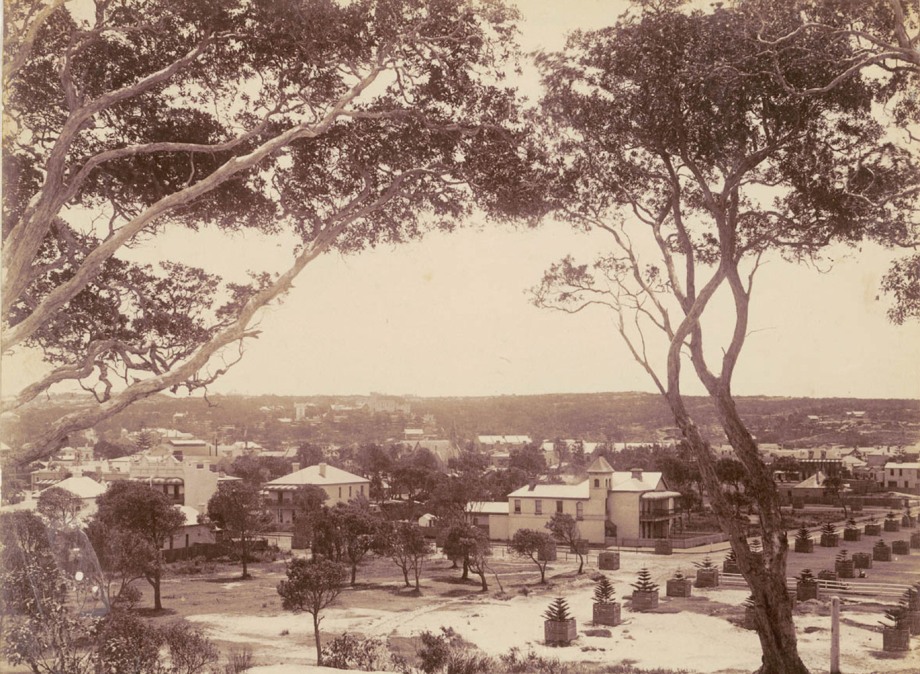
View of Manly- circa 1880 -Image No.: a089686; In the foreground, residences and pines protected by tree guards; Looking toward 'Marinella' (Dalley's Castle, built in 1881 for William Bede Dalley) at centre, courtesy State Library of NSW
"Scotty the Wrinkler," now passed on, whose observations on the manners and morals of bugs, butterflies, and blue gum, showed him a keen student of Nature, and a valuable historian of the same, stayed, when in town, at Dalley's Rest, as did many other writers. The Castle was built principally out of the stone of the district, and is the shell of what, when completed, would have been a truly magnificent mansion, though it was a superstructure on one of three stone cottages built many years previously on the hill. Two stone lions guard the entrance, where a courtyard, with a large lamp, stands, as in castles in days of yore. A private chapel was evidently intended to occupy a central position in the house, whilst in the library is a very fine piece of chiselled stone work from local freestone — a uniquely designed fireplace and mantel, perhaps the only one of its kind in the States. "Mr. Dalley always employed local labour, and he paid handsomely for it,” was the verdict of all with whom he had dealings.
After Mr. Dalley's death the estate fell into the hands of a syndicate, who sold it to the present owner. An interesting souvenir of early times is in the possession of one of Manly's earliest residents, Mrs. J. T. Smith, whose husband owned considerable property in the district. It is a standing clock, on something the pattern known as the "grandfather's clock," which was one of eight, the first built in the colony. Its biography is inside the case. "Governor Macquarie wished to know if it were possible for good and satisfactory timepieces to be constructed in the colony, therefore Mr. Oatley undertook to make eight clocks at £40 each, the purchasers being Governor Macquarie, the Rev. Mr. Cartwright, minister of St. James', Major Druitt,
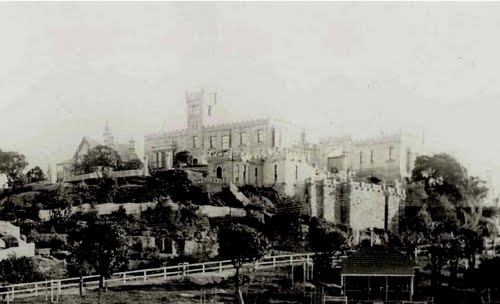
"DALLEY'S CASTLE" AT MANLY.
William Hutchinson, Rev. Fulton, Mrs. Throsby. The name of the eighth buyer is left out. In 1838 this clock was sold at the Rev. Cartwright's sale to Mr. Elijah Hayes, whose good and faithful servant it was till 1877, when it became the property of his daughter, who now treasures it.
"Manly possesses its "Haunted House," built by one Wilson, which is now in ruins, and stands on a hillock close to the road leading to Narrabeen, in a lonely and desolate spot. But no crime especially attaches to the locality, though a tragedy took place there. The type of lady of which many of our early colonists were made up was the accomplished society belle, who never had to "soil her hands," and for whom life should always be a bower and a bed of rose leaves. Such was the last resident of the Haunted House, a relative of the historic Froude. One day, in endeavouring to light a fire in the yard (in the absence of the difficult-to-obtain servant in those times), her clothes ignited, and she was literally roasted to death. Such tragic occurrences were not rare in days of log fireplaces in the open, with camp-ovens in which to roast, and a new spade to do duty for a frying-pan.
The little weatherboard cottages, let furnished for the summer season for honey-moon couples, or to pack in the bundle of children from the country, that lined the harbour esplanade, have nearly all been replaced by large, handsome houses, the past twenty years having rebuilt Manly, as Mr. Robey (the land agent) tells one. Visitors of some years back will remember that where Dr. Hall said Mr. Underwood now live was a temperance hotel; then came Mrs. J. T. Smith's cottages, then a large space, and the first house on the east beach, the home of the veteran fisherman and boat-man, Mr. Skinner, whose son has spent a life of nearly fifty years in Manly. Years back the wicked little flea devoted itself to the district in such numbers that blankets, carpets, and rugs would be carted off to the nearest ant hill, and spread over it, where-upon would ensue a struggle for the survival of the fittest.
Goats also were a curse to early residents, till "Goat Saturday" was instituted, when such slaughter took place that nannie and billy were almost effaced in Manly. Among old residents was the Hon. George Thornton, of whom it was said "that when Captain Cook came into the harbour he found George Thornton fishing for schnapper on the rocks." He established Struggle-town, near the top of the Red-road, by cutting his estate into small pieces, on which were built kerosene-tin cottages and case-linings villas. Mr. John Jackson Calvert (from 1871 clerk of Parliaments) has chosen this suburb for his home for many years. A tragic affair, that threw Manly into a commotion, was the burning of the fishermen's nets by vitriol on the ocean beach, away beyond Curl Curl. It is said to have been a sort of vendetta, originated by some badly-disposed men in the village, and schemed in the pavilion. Some of those concerned were punished by fines, amounting, it is said, to £300, but it is questioned if the right men were reached.
Where Ebenezer House used to stand is now the Good Samaritan Convent. Under-cliff, under the kangaroo, was the home of Mrs. Charles Smith, next to which was the old national school, where Mr. Lee, of soup kitchen note, was master. Petersville was the family home of the Peters, one Miss Peters being now Lady Broun, another(Mrs. Grimes, a talented woman) was blown over the South Head some years ago. Where Mr. R. M. Pitt lived is now occupied by Mr. John Woods, Mr. Alexander Dean's being next door. "Forty Baskets," a beach opposite Fairlight — so called from a fabulous haul — was where the Rev. Mr. Smith, of St. Barnabas' Church, died. This gentleman, the most powerful preacher of his time, is said to have reformed the Black Wattle Swamp and Black friars people; his son now lives on Smedley's Point, nearly opposite to Dobroyde Head. This piece of rocky ground, once a wild geebung forest where the little wharf for coaling the Phantom was its only erection, is now esplanaded and covered with beautiful villa homes, the splendid corporation baths being situated near the point, called after Mr. Smedley, of Ambrose, Thomley, and Smedley, architects.
Where the cricket ground now is was Savage's run for his cattle, Mr. Savage, who had travelled for the British Museum, settling there, and keeping a dairy across the road from where is now the cemetery. Mr. John Young bought the iron pavilion from the first exhibition at Prince Alfred Park, and put it up in what is now the cricket ground, where it was the cause of many rows, being used for "dancing" picnics of a rough type. Thirty years ago Adrian's Hotel stood in the park. The Church of England was first held in a school-house that stands near the Corso, on the ocean end. The Rev. Mr. Agnew was the clergyman; he had only one arm. He afterwards had an independent church in Bourke-street, Woolloomooloo, the Rev. George Gurney being the first resident clergyman. The Rev. George Tuckwell was for many years parish priest, whilst "Elijah" John Alexander Dowie officiated for the Congregationalists, where he is remembered as a fine preacher. The Rev. Mr. Gardiner, the present Presbyterian minister, is considered one of the finest preachers in Australia, in spite of the fact that he is almost blind.
Mr. Charles Brooke had an hotel near Fairy Bower, overlooking what is now Shell Harbour, but was then known as Cabbage Tree Bay, from the number of those trees in the neighbourhood. Fairy Bower was a sort of picturesque tea garden, kept by Mr. Grumington, who took great pride in his ornamental seats and the winding paths and steps that caused it to be much frequented by visitors. The Clarendon Hotel, with Mrs. Kilminster as hostess, is almost historic, as she came to live in Manly the week after the wreck of the Dunbar, when the Corso was a swamp, over which wooden planks led to a miserable little wharf. The Pier Hotel, first kept by Mr. Cohen, was a weatherboard erection, with a long cottage at the back. Only the dining-room of the original structure remains. The Steyne is also approaching its jubilee, having for hosts Messrs. Griffiths, Cohen, Grocott, Lamburne, Cousens, and Rosenthal. The Square and Compass was kept by Mr. Bagnall, and the New Brighton by Mr. A. Russell.
Among talented ladies who have belonged to Manly, one may mention Miss Maud Fitz-Stubbs, Miss Hilda Mulligan, Miss Kilminster, the clever pianist; Miss Latimer, who takes juvenile lead in the Wilson Barrett Company, now in London; Miss Gertrude Lyndon and Miss Deena Cooper, also young actresses; also Miss Stella Montagu, whose nursing career has been very successful, Manly possesses a very well managed cottage hospital, situated on the heights over-looking the ocean. The gloomy and forbidding point known as Dobroyd Head, with its snarling teeth of cruel rock, belongs to Manly Municipality, where the bomborer has swamped so many boats, drawing them with irresistible force to their destruction. There Lieutenant Gowland lost his life when out surveying, and later on a young English lady, just arrived with her husband, was drowned, whilst he, with a companion, Lieutenant Bance, escaped. No wonder that their after lives were mere broken threads!
The Manly flower show, which was first held in 1881, has been an annual event ever since. It was got up by a committee of ladies, and was certainly one of the most beautiful sights the colony had ever seen. The net profit was £200 for the Anglican Church (begun 1863), and in the second year the debt was cleared off. The third year admitted the Congregational Church to a share, in 1884, the net profit being £1000. Lady Jersey was the first woman to make a public speech in Manly, at the opening of a flower show, and she spoke in extreme praise of the wealth of natural beauty that was so bountifully showered upon the fortunate residents of what she designated a "Paradise in villages."
Manly is now more than up-to-date, having a "chute" in summer, Continental surf-bathing, and public motor cars. Boys to boggan down Red Hill, and a tram (not quite of the latest design) runs from the wharf to Curl Curl. Of cabs there are plenty. A merry-go-round, the proprietor of which is so rich that he uses sovereigns for his coat and trouser buttons, is permanently undercover in the Corso. The streets are well lighted with gas, though the spaces between them is so narrow that one side has to be the back yards of the other thoroughfare's houses. This style of road architecture is accounted for by the fact that the bullock team and the short-cutter to the ocean beach were the earliest street architects.
The question of a tramway from Watson's to Manly is actively discussed, there being many opinions, both for and against. Meantime Manly appears both happily and prosperously situated, and is going ahead.
THE SUBURBS OF SYDNEY. (1904, June 25). Evening News(Sydney, NSW : 1869 - 1931), p. 3 Supplement: EVENING NEWS SUPPLEMENT. Retrieved from http://nla.gov.au/nla.news-article113903625
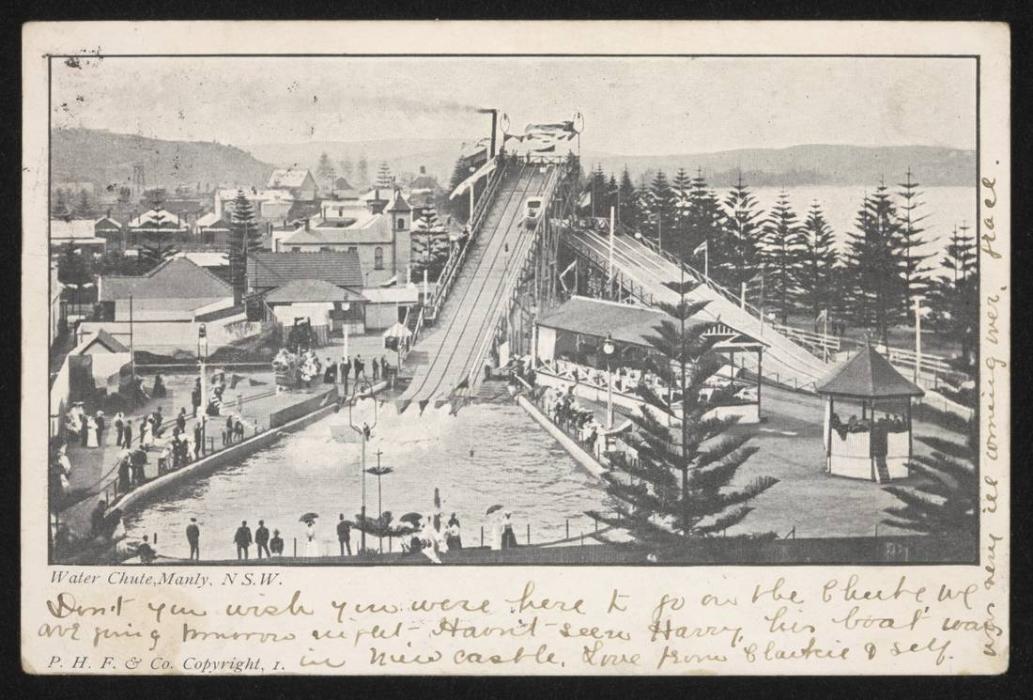
THE MANLY CHUTE.
The Manly Water Chute and Amusements Company have issued an attractive guidebook profusely illustrated, setting forth the numerous attractions at the company’s grounds at Manly. The chute, toboggan. Bijou Theatre, and the fiery dragon are all depicted, and the letterpress is well and smartly written. Trippers to Manly (the Brighton of Australia) who have not yet experienced the sensation of " chuting" on reading the brochure, will no doubt be tempted to " take the plunge." The little book is a credit alike to its author, printer, and all concerned. THE MANLY CHUTE. (1904, May 7). Watchman (Sydney, NSW : 1902 - 1926), p. 3. Retrieved from http://nla.gov.au/nla.news-article111920950
Water Chute, Manly, N.S.W. , courtesy National Museum of Australia, Image No.: 1986.0117.0258 - from an old Postcard.

“There were many stonemasons working for Henry Gilbert Smith in Manly at this time, and some people accept the story that Henry commissioned one of them, perhaps Thomas Youl, to fashion and erect the statue on the hill as a point of interest for visitors.
However, it is claimed in the obituary of a photographer, Charles Pickering, that he was residing in Manly in 1857, and carved the Kangaroo in his spare time.” - Champion & Champion, Manly, Warringah and Pittwater 1850-1880, p11
Further (From George Champion OAM and Shelagh Champion OAM): Thomas Youl owned a large amount of land near present Manly Lagoon in 1854. He sold some of it to H.G. Smith in 1855.
Youl appears as No 1472 on the Electoral 1859-60 for St Leonards, Residence Manly Lagoon, Qualification freehold, House and Land Manly Lagoon. He also appears in Sand's 1861 Directory as, Youll, Thomas, mason, Manly Lagoon. Soon after 1861 I think he may have died.
Above Illustration enlarged portion from: CHRISTMAS IN AUSTRALIA. (1865, December 16). Illustrated Sydney News (NSW : 1853 - 1872), p. 3. Retrieved from http://nla.gov.au/nla.news-article63512709
Below:
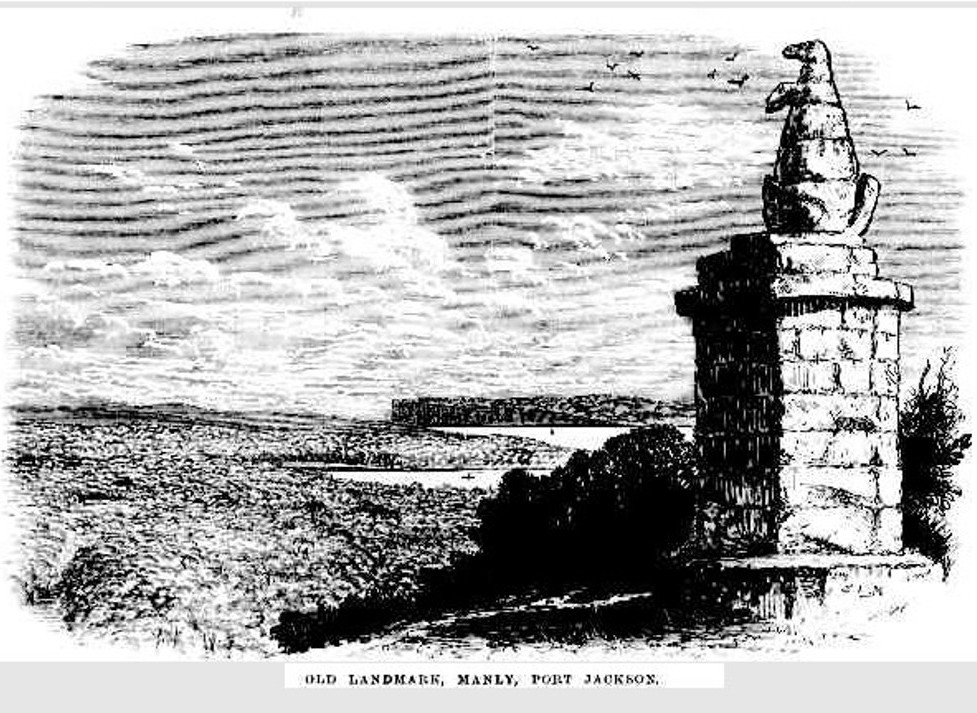
The kangaroo was erected by H.G. Smith – founder or ‘father’ of Manly around 1857 – Picture from: OLD LANDMARK, MANLY, PORT JACKSON'. The stone kangaroo, of somewhat primitive fashioning, which forms a prominent object in our engraving, is well known to most of the numerous pleasure-seekers at Manly, Port Jackson. It was erected by a local resident and property owner, and stands on the crown of a rocky hill, whence maybe obtained an excellent view of the pleasant little village of Manly and of the many charming villas that dot the slopes of the hills. Manly Bay is also to be seen, together with the South Head and entrance to Port Jackson. Sketches with Pencil. (1875, May 15). The Australasian Sketcher with Pen and Pencil (Melbourne, Vic. : 1873 - 1889), p. 19. Retrieved from http://nla.gov.au/nla.news-article60606767
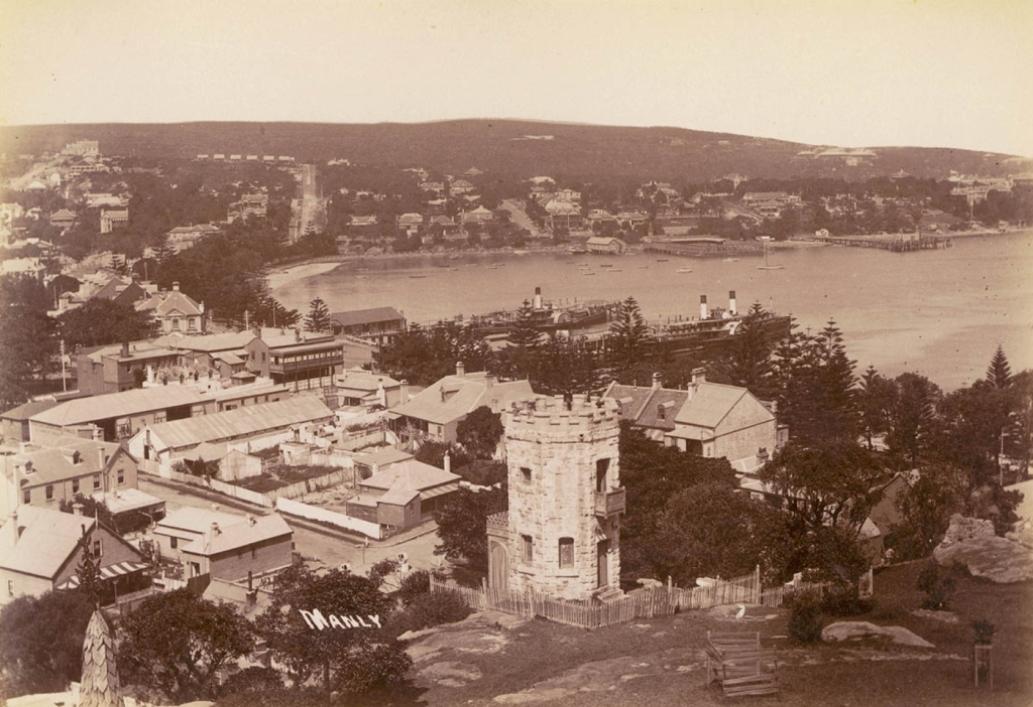
View - Manly [possibly from Dalley's Castle] - shows original Camera Obscura - Date of Work ca. 1900-1910, Image No.: a116266, courtesy State Library of NSW.
How to Make a Camera Obscura and a few other Notes:
The Camera Obscura.
In making a camera obscura the first thing we want to know is the focal length of the lens we are going to employ, as upon this will depend the size of the box we have to use.
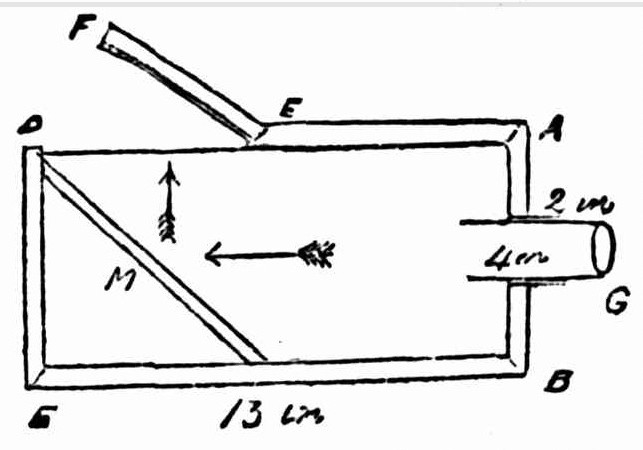
The length of the box has to be rather less than the focal length of our lens. Thus, if the focal length of our lens for objects some yards off be say 15 inches, we may make our box 13 inches long and about 8 inches deep, and 8 inches wide. A round hole must be made into one end (a. /), just sufficiently large to allow the tube containing a double convex lens to work backwards and forwards smoothly (Fig. 1). A mirror (in) is fixed at the other end, at an angle of 45', so that it reflects all light coming from the round hole upwards in the direction of the arrow. One portion of the side ( a d) is made into a door (c /), turning on hinges at e. At e d a square plate of ground glass or smooth glass may be placed, just as required. And now as to the double convex lens. A paper tube may be made of such a diameter as to hold it at one end, and in passing we may say that such paper tubes are very readily made by rolling the paper round a wooden cylinder of requisite diameter, and, as each turn of paper is wound on, gumming it well down. When the gum is dry a good tube is procured. Around the paper tube that has been made another may now be wound, about two inches long, and this will have to be fixed to the hole at the end of the box (a b ), so that the tube of lesser diameter containing the lens may slide backwards and forwards. Paint the inside of the box black, and of the tubes too. And now, if everything be in order, we may proceed to work with our camera. The ground glass is fixed at ed, the lens at g, focussed for the external street or landscape, and we now find them pictured on the ground glass in form and colour mavellously like the scene without. If we wish to make a drawing, the ground glass must be replaced by a sheet of clear glass, and on this tracing paper may then be fastened down, and with a sharp pencil point the outlines of the picture are now readily drawn.
The camera obscura has been employed for warlike as well as gentle purposes, and it was used in this way on the occasion of the defence of Venice in 1859. The Austrians who held the city were afraid that the Italians might suddenly come upon them, and part of their defensive measures was the erection of a large camera obscura (Fig. 2).
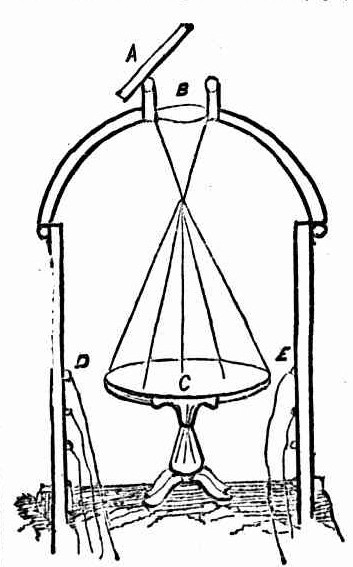
You will perceive from the figure that this camera when built was not unlike the one you have perhaps now made, for there is a double convex lens (6) at one end of it, and at the other a screen (e) in the shape of a table with a white -top. The Venetian camera was built on a rock overlooking the harbour, so that by means of a looking-glass at a a beautiful picture of it was cast on to the table, and it is apparent that a person standing by the table could see the movements of all vessels, whether of peace or of war, that came towards the city. Torpedoes were now sunk in the harbour, and the point where each numbered torpedo was sunk was marked on the table. Torpedoes, as you may be aware, are fired by means of wires leading from them to the shore, and in this case to the inside of the camera (d c),hence at the end of the operation torpedoes had been planted in different parts of the harbour, and the soldier within the camera could tell exactly where each one was, and which wires communicated with it, so that he had it in his power, while watching the picture on the table, to blow up any Italian ship that might come near one of the sunken torpedoes. The Camera Obscura. (1886, February 6). The Sydney Mail and New South Wales Advertiser (NSW : 1871 - 1912), p. 307. Retrieved from http://nla.gov.au/nla.news-article162811341
Mr Meredith, the comedian, has, with much labour and expense, fitted up a Camera Obscura of very large dimensions. We believe it is the first of the kind which will be exhibited in Australia. It may be seen at Macquarie Fort this day, and will be seen on the Race Course during the playing of the Cricket Match on Monday next. ANNIVERSARY REGATTA. (1839, January 26). The Australian (Sydney, NSW : 1824 - 1848), p. 2. Retrieved from http://nla.gov.au/nla.news-article36859496
MANLY.-CAMERA OBSCURA.-Parties desirous of renting the tower in which the above is placed, and establishing a photographia apparatus therein, can obtain particulars on application to Mr. H. G. SMITH, Manly. MANLY.-TO ENGINEERS. - CONTRACTS are invited for the erection of a small steam-engine, and to lay down the requisite pipes for supplying the baths now in course of erection at Manly. Particulars can be ascertained on application to Mr. H. G. SMITH, Manly. 071) Advertising. (1857, January 13). Empire (Sydney, NSW : 1850 - 1875), p. 1. Retrieved from http://nla.gov.au/nla.news-article60276812
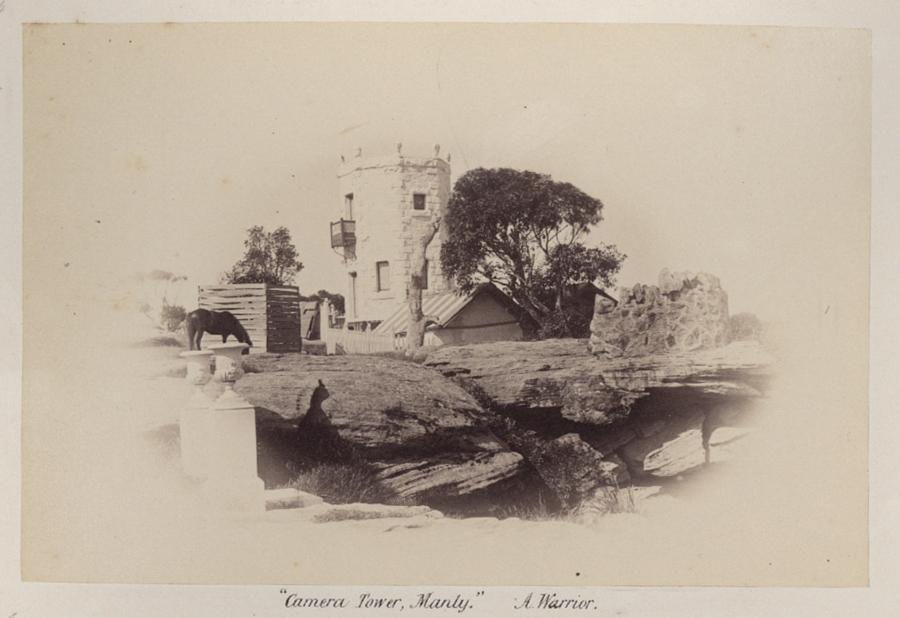
1884 - 1886: By Warrior, A. Contributed by Graham Trevena [Page 4a] (from the album 'Works by Members of the Amateur Photographic Society of N.S.W presented by the Society to His Excellency Lord Carrington August 1886') - retrieved from The Dictionary of Sydney.
THE STORY OF THE CAMERA
Any boy or girl can have a camera nowadays for a few shillings and take pictures with hardly any trouble. But it is not many years since photography was more a difficult business than a pleasure, and less than a century since the earliest camera was made. Photographic films and plates are coated with gelatine and a silver substance which is sensitive to light, and which makes a permanent picture of whatever the camera lens sees. It was in 1732 that a scientist named Schulze discovered that this silver was darkened by the light, but his discovery was put to no practical use until early in the 19th century. At that time there was a fashion for making silhouettes. Somebody was posed so that the light from the lamp threw the profile of his face in sharp shadow against a white screen. It was then easy to obtain a silhouette picture by either outlining the profile or cutting it out from the screen. But it occurred to a man named Wedgwood that the profile might be printed on the screen by using paper treated with silver nitrate, and he not only accomplished this, but also made the camera obscura, the forerunner of the camera we use today.
Then Sir Humphrey Davy succeeded in making photographs through a microscope by using the sunlight These were the first pictures produced by a lens on photographic material ; but it was not until Sir John Herschel discovered hypo that the proofs could be made permanent. In about 1840 Daguerre invented his process of making pictures on copper which was silver-plated on one side. But by his methods anyone sitting for a photograph was a martyr. The poor victim had to stay motionless in the sun for many minutes with face thickly coated in powder. So, little by little, improvements were made until the first film roll camera appeared in 1888. After that, taking a photograph took less time, and loading and unloading could be done in daylight. And most recently has come autographic photography, so that the amateur, by putting a date and a title on each negative after exposing it, may make a written record of his work as well as a pictorial one. THE STORY OF THE CAMERA. (1919, August 10). Sunday Times (Sydney, NSW : 1895 - 1930), p. 21. Retrieved from http://nla.gov.au/nla.news-article123222323
Camera Experiments. L.G. (Enoggera, Qld.): It was Baptista Porta, a Neopolitan by birth, who popularised the camera obscura, which at that time appears to have been a dark room, into which spectators were taken in order to see the wonders of image-forming by a lens. Those were pre-photographie days, but every form of camera now used is actually a dark chamber, into which the image of external objects may be projected by means of a lens. It seems that one of the first persons to construct and use a portable form of camera was Kepler, using nothing more than a little black tent fitted with a convex lens, into which he would retire, and trace with his pen the image of some external object, which was projected upon a sheet of white paper. The old term, camera obscura, is now shortened to camera, excepting in a few cases, where an old-style camera is used as an exhibition, or for the purpose of viewing exterior objects, views, &c, per medium of an image-forming lens. The first photographic camera seems to have been constructed by Nicephore Niepce, about the year A.D. 1816. Queries ?. (1935, December 5). The Catholic Press (Sydney, NSW : 1895 - 1942), p. 2. Retrieved from http://nla.gov.au/nla.news-article104502340
There was no formal Obituary or thanks published for Mr. Smith after his death – just a simple notice and prior to this, in January 1886, advertisements for the selling of his estate/home, named ‘Fairlight’:
SMITH -April 1, at the Langham Hotel, London, Henry Gilbert Smith. Esq., formerly of Fairlight, Manly. Family Notices. (1886, May 19). The Sydney Morning Herald(NSW : 1842 - 1954), p. 1. Retrieved from http://nla.gov.au/nla.news-article13636651
MRS. MARY SALMON.
The death is announced of Mrs. Mary Frederica Salmon, who was widely known as a writer of articles on the early history of Sydney and its prominent families. She died at her home in Blue's Point-road, North Sydney, yesterday, at the age of 84 years.
Mrs. Salmon was born at sea on a Dutch sailing vessel, on which her family came to Australia to settle. Her father, the late Mr. John Matthew Wright, was in business in Sydney as a chemist. She was trained as a teacher at the old Fort-street Training College, under Mrs. McTaggart. After teaching in several city and country schools, she became English mistress at Springfield Ladies' College, conducted by Lady Murray, the wife of Sir Terence Aubrey Murray.
In 1888, she married Mr. James Salmon, an accountant. He died a few months after the marriage, and Mrs. Salmon then took up journalism, contributing articles to the daily and weekly Press of Sydney. On her 84th birthday, many of her former pupils of Springfield College called on her to offer good wishes.
The funeral, which will be a private one, will take place at Gore Hill Cemetery this morning. MRS. MARY SALMON. (1937, January 8). The Sydney Morning Herald (NSW : 1842 - 1954), p. 17. Retrieved from http://nla.gov.au/nla.news-article17314806
Manly's Stone Kangaroo, Camera Obscura, First Maze and 'Chute' - Fun Days in Sea Hazes from 1857 On - threads collected and collated by A J Guesdon, 2014 - with thanks to George and Shelagh Champion for clarification on details.